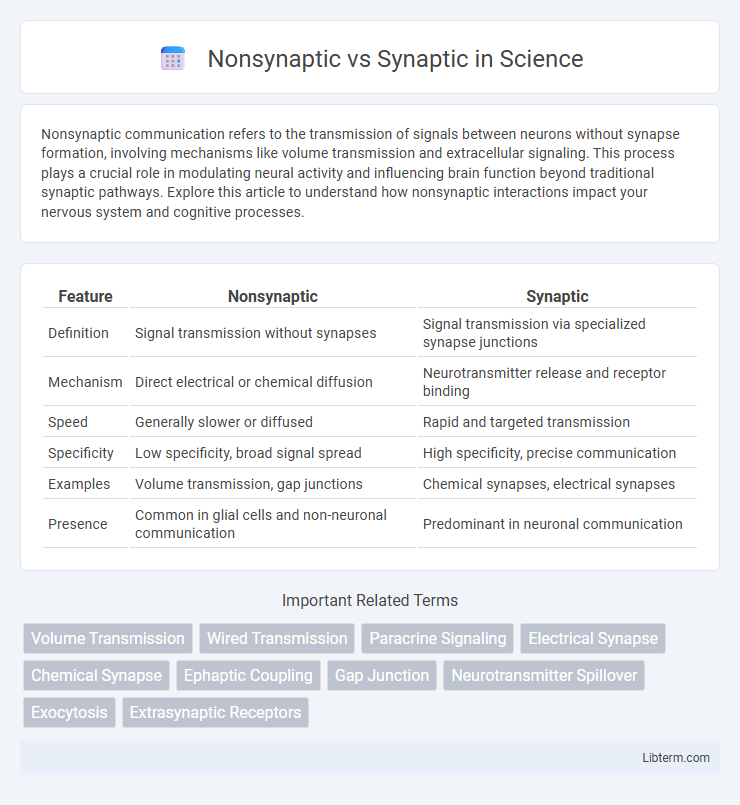Nonsynaptic communication refers to the transmission of signals between neurons without synapse formation, involving mechanisms like volume transmission and extracellular signaling. This process plays a crucial role in modulating neural activity and influencing brain function beyond traditional synaptic pathways. Explore this article to understand how nonsynaptic interactions impact your nervous system and cognitive processes.
Table of Comparison
| Feature | Nonsynaptic | Synaptic |
|---|---|---|
| Definition | Signal transmission without synapses | Signal transmission via specialized synapse junctions |
| Mechanism | Direct electrical or chemical diffusion | Neurotransmitter release and receptor binding |
| Speed | Generally slower or diffused | Rapid and targeted transmission |
| Specificity | Low specificity, broad signal spread | High specificity, precise communication |
| Examples | Volume transmission, gap junctions | Chemical synapses, electrical synapses |
| Presence | Common in glial cells and non-neuronal communication | Predominant in neuronal communication |
Introduction to Neural Communication
Neural communication involves two primary mechanisms: synaptic and nonsynaptic transmission. Synaptic transmission occurs through specialized junctions called synapses, where neurotransmitters are released from a presynaptic neuron to bind receptors on a postsynaptic neuron, enabling precise and rapid signal propagation. Nonsynaptic transmission, also known as volume transmission, involves the diffusion of neurotransmitters or neuromodulators through extracellular fluid, affecting multiple neurons over a broader area and contributing to modulatory and tonic signaling in neural networks.
Defining Synaptic Transmission
Synaptic transmission refers to the process by which neurons communicate through specialized junctions called synapses, involving the release of neurotransmitters from the presynaptic neuron and their binding to receptors on the postsynaptic neuron. This mechanism enables rapid and targeted signal propagation crucial for brain function, learning, and memory. In contrast, nonsynaptic transmission involves the diffusion of neurotransmitters or modulators through the extracellular space, affecting multiple neurons without direct synaptic contact.
Exploring Nonsynaptic Communication
Nonsynaptic communication involves the transmission of signals between neurons without direct synaptic connections, utilizing mechanisms such as volume transmission and extracellular signaling molecules like neurotransmitters and neuromodulators. This form of neural communication influences widespread brain regions and modulates neuronal networks by diffusing through the extracellular space, impacting receptor sites distant from the original signaling neuron. Understanding nonsynaptic communication enhances insights into complex brain functions, including plasticity, homeostasis, and neuroimmune interactions beyond traditional synaptic transmission.
Key Differences: Synaptic vs. Nonsynaptic Signaling
Synaptic signaling involves the transmission of chemical signals across a synapse, characterized by rapid, targeted communication between neurons through neurotransmitters. Nonsynaptic signaling, or volume transmission, relies on the diffusion of signaling molecules like neuromodulators over broader areas, affecting multiple cells without direct synaptic contact. Key differences include the precision, speed, and spatial reach of signal propagation, with synaptic signaling being fast and highly localized, while nonsynaptic signaling is slower and affects larger neural networks.
Molecular Mechanisms Involved
Nonsynaptic communication relies on volume transmission where neurotransmitters diffuse through extracellular space, engaging receptors distant from the release site, involving molecular players such as transporters, extracellular enzymes, and extrasynaptic receptors like GABA_B and NMDA receptors. In contrast, synaptic transmission is characterized by precise, rapid neurotransmitter release into the synaptic cleft, mediated by SNARE proteins, voltage-gated calcium channels, and postsynaptic density proteins that facilitate receptor clustering and signal transduction. Molecular mechanisms in both types include neurotransmitter synthesis, vesicular release, receptor binding, and signal termination, but synaptic communication is spatially and temporally confined, whereas nonsynaptic signaling modulates broader neural networks via diffusion and diverse receptor activation.
Roles in Neural Circuit Function
Synaptic transmission involves the precise release of neurotransmitters across synaptic clefts, enabling rapid and targeted communication between neurons, which is essential for encoding and processing specific neural signals. Nonsynaptic mechanisms, including volume transmission and extrasynaptic receptor activation, modulate neural circuit activity by diffusing neuromodulators over broader areas, influencing neuronal excitability and synaptic plasticity. These complementary roles ensure both fast, localized signaling and widespread regulatory control within neural circuits, critical for dynamic information processing and network stability.
Advantages and Limitations of Each Mode
Nonsynaptic communication allows for widespread signal diffusion, enabling the simultaneous modulation of multiple target cells, but its lack of specificity can lead to unintended effects and reduced signaling precision. Synaptic transmission offers highly specific and rapid communication between neurons, ensuring precise point-to-point signaling, though it requires complex structures and is limited to direct cell-to-cell contacts. The trade-off between the broad reach of nonsynaptic signaling and the accuracy of synaptic transmission defines their functional roles in neural networks.
Implications for Neurological Disorders
Nonsynaptic and synaptic mechanisms play distinct roles in neuronal communication, with nonsynaptic transmission involving extrasynaptic receptors and gap junctions that modulate neuroglial interactions and network excitability. Dysregulation of nonsynaptic signaling pathways, such as altered ion channel function and neurotransmitter diffusion, contributes to pathologies like epilepsy, neurodegeneration, and chronic pain by disrupting ionic homeostasis and neuroinflammation. Targeting both nonsynaptic and synaptic abnormalities offers therapeutic potential for neurological disorders including Alzheimer's disease, Parkinson's disease, and multiple sclerosis by restoring synaptic plasticity and reducing aberrant neuronal hyperexcitability.
Current Research and Breakthroughs
Recent research highlights distinct mechanisms governing nonsynaptic and synaptic communication, emphasizing the role of extracellular ion fluxes and volume transmission in nonsynaptic signaling. Breakthroughs in imaging and electrophysiological techniques have uncovered how nonsynaptic currents influence neural circuit modulation and neuroplasticity beyond traditional synaptic interfaces. Advances in understanding nonsynaptic pathways are driving novel therapeutic strategies targeting neurological disorders by modulating extrasynaptic receptor activity and ion channel dynamics.
Future Perspectives in Neural Communication
Future perspectives in neural communication emphasize the growing significance of nonsynaptic transmission, which offers novel mechanisms for modulating neural networks beyond traditional synaptic connections. Advances in imaging and electrophysiological techniques are expected to elucidate the complex roles of volume transmission, neurotransmitter spillover, and glial-neuron interactions in cognitive processing and neurological disorders. Understanding these nonsynaptic pathways promises to enhance therapeutic strategies for neurodegenerative diseases by targeting diffuse signaling mechanisms alongside classical synaptic targets.
Nonsynaptic Infographic

 libterm.com
libterm.com